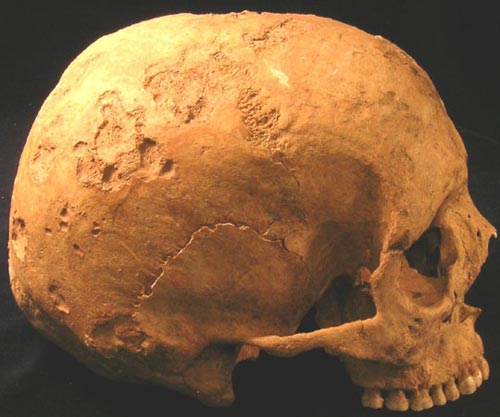Write the Bible to make the clergy poisoned
Medieval bones from six different Danish cemeteries show that clergy - those who write the Bible and other religious documents - may have been exposed to toxic mercury, used to create a in their ink colors: red.
The work will be published in the August issue of the Journal of Archaeological Science, which also describes a disease not previously reported, called FOS, similar to leprosy and brain damage. In addition, the researchers found that mercury-containing drugs were given to 79% of individuals with leprosy and 35% to syphilis.
Because clergy, who were buried in the monastery of Cistercian Monastery, did not suffer from these diseases but their bones had mercury, scientists believed that clergy were poisoned when preparing and administering. medicine, or when writing artistic letters of early books, or books before 1500 BC.
Kaare Lund Rasmussen, a Danish University scientist, of the Institute of Physics and Chemistry, doubted that the ink used in the library's manuscripts was the cause. He told Discovery News, 'People know how to lick their palms if they want to draw beautiful lines.'
Even today, 'people should not touch or rub the parchment pages of a primitive book.' Lund Rasmussen added that mercury 'was used since the beginning because of mercury sulfide (HgS) for out a brilliant red. '

The skull is damaged
Photograph of a skull bone excavated from an early medieval Danish cemetery called Nordby. This skull shows that FOS, a previously unrecognized disease, similar to leprosy, has eroded this person's bones. (Photo: Kaare Lund Rasmussen)
It is well known that metallic liquid mercury is introduced into patients in the form of vapor. So if the clergy is only slightly careless, they will absorb it this way. However, they can also absorb mercury during the preparation of the medicine. '
In this work, Lund Rasmussen and his team drilled into bone specimens of the buried people, some of whom were buried under the path of the Franciscan Monastery at Svendborg. Unlike clergy, the monks have no signs of being poisoned.
Deadly manuscripts

Death draft?
An example of artistic biblical texts drawn by clergy. Red ink containing mercury may have poisoned people who use it. (Photo: The Yorck Project)
Co-author Jesper Lier Boldsen discovered the disease was not previously recorded while examining the skeleton. Lund Rasmussen said 'We do not know whether FOS is deadly, but it certainly seems painful and also as serious as leprosy.'
During the study, the scientists also noted that, thanks to different carbon signs, some medieval people had a diet that was mostly marine fish. Lund Rasmussen thinks that others 'prefer meat and beer to fish and water.' The Cistercians, in principle, are not allowed to eat four-legged species, but the Franciscans do not seem to be forced to follow this practice. '
Although modern seafood may contain high levels of mercury from environmental pollution, food poisoning may not occur in the Middle Ages. Religious groups may also suffer from mercury poisoning by drafting sacred texts. In a separate study, scientists at the Soreq Nuclear Research Center in Israel and the Israel Museum discovered HgS in four pieces of the Episodes, including passages from the Jewish Bible.
Kurt Villads Jensen, a Danish university historian, told Discovery News he believed that the discovery of medieval mercury seemed "very convincing" and that he "absolutely had no objection to historical aspects." My main field of study. '
Lund Rasmussen and his team used radioisotopes to determine the age of the studied bones, but they hoped to do this for more people in the experimental group, as this could reveal more information. about the relationship between mercury poisoning and the use of red ink. Before 1536, books were no longer handwritten but printed, so scientists suspected that poisonous red ink almost disappeared from monastic paintings.
- AI learns to write code for themselves
- Greatly make medieval Bible books
- The mystery of the 2000 year old scroll
- The gene was discovered to make children slow to read and write
- Revealing the oldest Bible in the world
- Discover the first Bible with illustrations
- How does science explain the miracles of the Bible?
- 3D technology supports reading content of charred Bible copy
- Discover the mummy mask containing the oldest Bible copy
- Successfully decode the 1,500-year-old bible scroll
- Hidden text on the manuscript 'Dead Sea Bible'
- Write a message with water
 Discovered an ancient centipede fossil 99 million years old
Discovered an ancient centipede fossil 99 million years old Discovered bat-like dinosaurs in China
Discovered bat-like dinosaurs in China Discovered a 200-year-old bronze cannon of the coast
Discovered a 200-year-old bronze cannon of the coast Discover 305 million-year-old spider fossils
Discover 305 million-year-old spider fossils